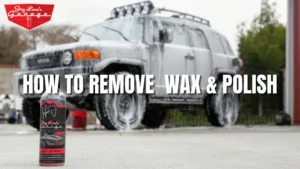Your car is more than just a mode of transportation; it’s an extension of your personality and a significant investment. Keeping it in pristine condition is crucial not only for aesthetics but also for its longevity. Regularly waxing your car can transform that dull, faded paint into a radiant finish that turns heads wherever you go. But the benefits extend far beyond mere appearance.
Imagine protecting your vehicle from harmful UV rays, dirt, and environmental contaminants while enhancing its resale value. If you’re wondering why waxing should be part of your regular maintenance routine, consider this: it’s one of the simplest ways to care for your ride without breaking the bank or spending hours at the shop.
Dive into our detailed look at the top five benefits of regularly waxing your car and discover how easy it is to keep that shine going strong! Whether you’re a seasoned auto enthusiast or someone who simply wants their vehicle looking sharp, these insights will help you appreciate every swoop and curve on those beautiful painted surfaces. Let’s get started!
Top 5 Benefits of Regularly Waxing Your Car: A Detailed Look
Regularly waxing your car offers a multitude of benefits that go beyond just aesthetics. First, it provides an essential layer of protection against environmental elements. UV rays, acid rain, and bird droppings can damage your paint over time. Wax acts as a barrier, keeping these harmful substances at bay.
Another significant benefit is the enhancement of your vehicle’s shine. A fresh coat of wax will make your car gleam like new, reflecting light beautifully and making colors appear more vibrant. This not only boosts its visual appeal but also gives you pride in ownership.
Additionally, waxing helps to prevent rust formation by sealing small scratches or imperfections on the surface. When moisture penetrates these tiny flaws without protection, rust can quickly set in. Regular waxing keeps those potential issues under control.
Routine waxing contributes to improved resale value. A well-maintained exterior signals to potential buyers that the vehicle has been cared for throughout its life. Investing some time in regular waxing pays off when you’re ready to sell or trade-in your beloved ride.
The Role of Waxes and Sealants
Waxes and sealants play a crucial role in car care. They provide an additional layer of protection against environmental elements like UV rays, dirt, and grime. This extra barrier can help maintain the integrity of your vehicle’s paint job.
Car wax is typically made from natural ingredients such as carnauba or beeswax. It offers a beautiful shine while enhancing depth and clarity. The application of wax creates a hydrophobic surface that repels water, making it harder for contaminants to stick to your vehicle.
Sealants, on the other hand, are synthetic products designed for longevity. They bond chemically with the paint surface, providing durable protection that can last several months longer than traditional waxes. Sealants often have superior resistance to chemical stains and oxidation.
Choosing between waxes and sealants depends on individual needs. If you seek immediate visual appeal complemented by ease of use, waxing may be ideal for you. But if long-lasting protection is your primary concern, investing in high-quality sealant might be more beneficial over time.
Wax or Sealant: Which Is Right for You?
Choosing between wax and sealant can be a bit tricky, as both offer unique benefits for your vehicle’s protection. Car wax is typically made from natural ingredients like carnauba, known for its deep shine and warmth. It creates a beautiful luster that many enthusiasts appreciate. However, it generally requires more frequent application to maintain its effectiveness.
On the other hand, synthetic sealants are engineered for durability. They provide a layer of protection that lasts longer than traditional waxes—sometimes up to six months or more. Sealants bond chemically with your paintwork, offering resistance against UV rays and contaminants like dirt or bird droppings.
If you love the look of freshly waxed paint and don’t mind the upkeep, waxing may be your best bet. For those who prefer low maintenance yet reliable protection over time, sealants might be the better choice.
Consider factors such as climate conditions and how often you’re willing to apply product on your vehicle’s surface. Understanding what each option offers will help you make an informed decision tailored to your needs.
How to Wax a Car and Apply Sealants
Waxing your car and applying sealants is a straightforward process that can yield impressive results. Begin by washing your vehicle thoroughly to remove dirt, grime, and old wax residue. Use a quality car soap and microfiber cloths for the best results. Rinse well and dry your car with clean towels to avoid water spots.
Once your car is clean, choose between natural wax or synthetic sealant based on the protection you desire. Natural wax provides a warm glow but requires more frequent application. Synthetic sealants offer longer-lasting protection with enhanced durability against environmental elements.
If you’re using paste or liquid wax, apply it in small sections using an applicator pad. Work in circular motions to ensure even coverage while allowing the product to haze over as per manufacturer instructions—usually around 5-10 minutes depending on conditions.
For sealants, follow similar steps but be mindful of curing times; some may need specific drying periods before buffing off excess product. Once finished, use a soft microfiber towel for buffing until you achieve that shiny finish everyone admires!
Durability and Maintenance
Regular waxing significantly enhances your car’s durability. A good coat of wax acts as a protective barrier against environmental elements. Sunlight, rain, and pollutants can all damage your vehicle’s paint over time. Waxing helps to minimize this damage.
Maintenance becomes easier with a well-waxed car. The smooth surface repels dirt and grime, making it less likely for contaminants to stick. When you do need to wash your vehicle, cleanup is quicker and more efficient because the soap glides off effortlessly.
Another advantage is that regular waxing can prolong the life of the paint job itself. It prevents oxidation, which causes fading or discoloration of the paint over time. By consistently applying wax every few months, you can keep that fresh-off-the-lot look for years.
Moreover, maintaining your car’s exterior through waxing adds resale value in the long run. Potential buyers are always attracted to vehicles that appear well-kept and shiny. Investing in regular waxing not only protects but also enhances both aesthetics and value.
Conclusion
Regularly waxing your car offers a multitude of benefits that go beyond just aesthetics. It acts as a protective barrier against environmental elements, helping to preserve the vehicle’s paint and finish. This not only enhances its appearance but also maintains its resale value over time.
Using high-quality car wax or sealants ensures you’re investing in the longevity of your vehicle’s exterior. The process itself is straightforward, making it accessible for anyone looking to enhance their car care routine. With proper application techniques and maintenance, you can enjoy a long-lasting shine that keeps your car looking brand new.
Whether you choose wax or sealant will depend on your specific needs and preferences—both have unique advantages worth considering. Regular waxing should be an essential part of any vehicle maintenance plan for those who want to keep their cars in top condition while enjoying the drive every day. Embrace this practice, and watch as your car transforms into a shining embodiment of pride on wheels.



